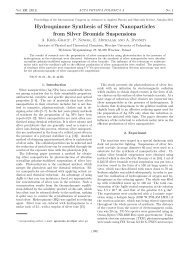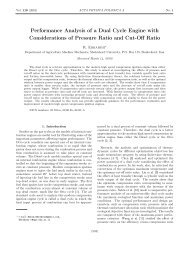Ultra Fine-Grained Metals Prepared by Severe Plastic Deformation ...
Ultra Fine-Grained Metals Prepared by Severe Plastic Deformation ...
Ultra Fine-Grained Metals Prepared by Severe Plastic Deformation ...
Create successful ePaper yourself
Turn your PDF publications into a flip-book with our unique Google optimized e-Paper software.
748 J. Číˇzek et al.<br />
2.2. Apparatus<br />
Conventional PAS. A BaF2 lifetime spectrometer described in Ref. [5] was<br />
employed in the course of present work. The spectrometer exhibited a time resolution<br />
of 150÷170 ps (FWHM) for 22 Na and a coincidence count rate of ≈ 100<br />
coincidence events per second. A carrier-free 22 NaCl (Amersham) positron source<br />
of ≈ 1.5 MBq strength sealed between 2 µm mylar D foils (DuPont) was used.<br />
The diameter of radioactive spot was ≈ 3 mm. At least 10 7 counts were collected<br />
in each lifetime spectrum. The measured spectra were decomposed in up to five<br />
exponential components (including ≈ 7% contribution arising from annihilation<br />
in the source) using the maximum likelihood procedure [5]. The conventional DB<br />
measurements were performed with a HPGe detector (1.7 keV FWHM at 511 keV).<br />
SPIS. SPIS measurements were performed on the magnetically guided<br />
positron beam facility “SPONSOR” at FZ Rossendorf [6]. Line shapes of annihilation<br />
γ-rays were measured with a HPGe detector having an energy resolution<br />
(FWHM) of 1.09 keV at 511 keV. The beam diameter at the sample surface was<br />
≈ 4 mm. The dependences of annihilation line shape parameters S on positron<br />
energy E were measured in the interval E = 30 eV ÷ 35 keV and analysed <strong>by</strong><br />
means of the VEPFIT code [7].<br />
Other methods. TEM observations were performed using a JEOL 2000 FX<br />
electron microscope operating at 200 kV. XRD investigations were carried out on<br />
XRD7 and HZG4 (Seifert-FPM) powder diffractometers using Cu Kα radiation.<br />
The microhardness HV was measured <strong>by</strong> the Vickers method <strong>by</strong> means of a LECO<br />
M-400-A hardness tester with a load of 100 g applied for 10 s.<br />
3. Results and discussion<br />
In this section, the main results obtained on SPD-prepared UFG Cu, Ni, Fe<br />
and Cu + Al2O3 will be briefly presented while the details of these investigations<br />
have been given elsewhere [8–13].<br />
3.1. Characterisation of as-deformed UFG specimens<br />
All the UFG materials listed in Table exhibited two lifetime components.<br />
Corresponding lifetimes τi and intensities Ii (i = 1, 2) were shown in columns 2<br />
thru 5 of Table. As the measured lifetimes significantly exceed the respective bulk<br />
ones, both the observed components come from positrons trapped at defects. Thus<br />
saturated positron trapping takes place in the as-deformed specimens indicating<br />
high defect densities created <strong>by</strong> SPD.<br />
The dominating component with the shorter lifetime τ1 is slightly lower than<br />
the lifetimes of positrons trapped in monovacancies in respective materials which<br />
is typical of positron trapping at dislocations. For example, the lifetimes for monovacancies<br />
in Cu and Ni were observed [14] to be of 168–170 ps, i.e. <strong>by</strong> about 10 ps





